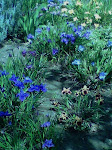Dear Gardenbear,
When is the best time to apply beneficial nematodes to my garden?
That’s an excellent question! Maybe we should start with what nematodes are, exactly:
The beneficial nematode is a microsopic worm that lives below the soil.
The picture seen here is of a juvenile nematode called a scarp. It is generally clear or white in color and has no segments like earthworms do. There are thousands of different kinds of nematodes that live in the soil. Nematodes are considered parasites and can affect a number of different plants and animals. Some species of nematodes are considered pests, but these are not the same species of beneficial nematodes used to control insects.
Apply nematodes after danger of frost is past. (They may be applied almost anytime, preferrably Feb-March in climated zones 8-10). I recommend a combination of beneficial nematodes (which are usually sold together in nurseries, under refrigeration.) These are Steinernema and Heterorhabditis. They spend their lives hunting and killing over 200 different species of insects that spend some part of their lives underground. They are a very efficient organic insect control method and kill most insects before they become adults. This includes lots of common lawn and garden pests such as grubs, fleas, mole crickets, japanese beetles and weevils (my personal favorite). These nematodes will not control or kill other types of nematodes already in the soil.
When a beneficial nematode attacks an insect larvae or grub it enters the body of its host. Generally within 48 hours that host insect will either die, be physically altered or unable to produce. The Steinernema and Heterorhabditis strains of nematode carry a bacteria that generally kills its host insect in quick fashion. The beneficial nematode then moves onto another host.
Beneficial nematodes prefer moist soil, but can live in almost any type of soil. Significant numbers are required to make sure that pest insects are controlled. We recommend the following distributions of nematodes:
| 1 Millon | 2 Million | 6 Million | 24 Million |
| (small yard or garden) | (larger yards) | ||
| 2000 sq. feet | up to 4000 sq. feet | up to 12,000 sq. feet | 1 acre |
Beneficial nematodes are sold in packets which can be stored refrigerated for several weeks. When you are ready to apply them, you simply mix them with water and spread them on the soil. I like to use a watering can for application. But they’re tiny enough to go through a sprayer nozzle. When they come, they’re usually dormant in a medium like finely ground bark. You re-constitute them in water. If you’re using a sprayer, strain the liquid before you put it in the canister. Greenhouses and indoor plant owners can also apply beneficial nematodes to indoor plants, the beneficial nematode will control gnats and fungus which inhabit the soil.
Beneficial Nematodes are available from The Beneficial Insect Company by the million. The following prices are approzimate:
| 1 Million $25.00 | 2 Million $42.00 | 6 Millon $50.00 | 24 Million $152.00 |


